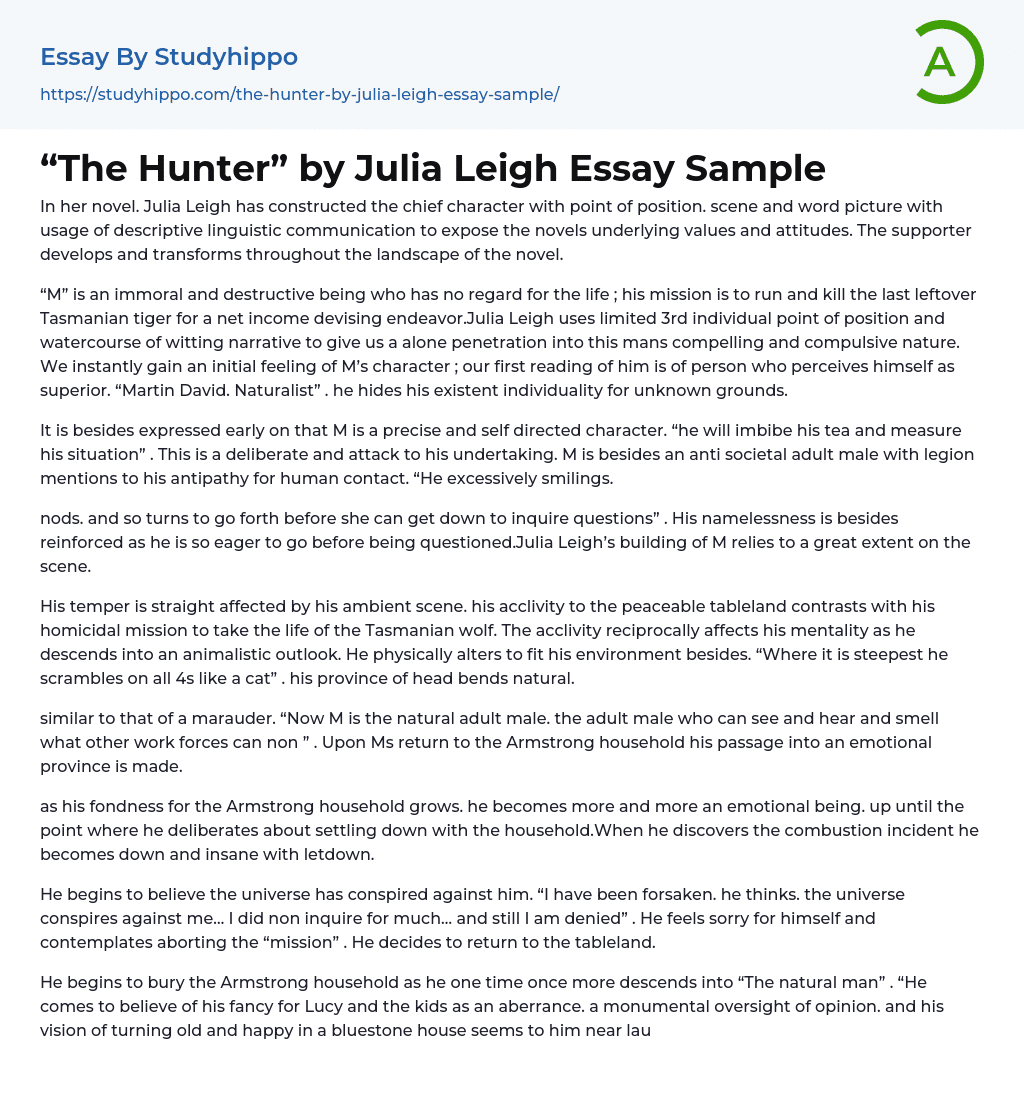In her novel. Julia Leigh has constructed the chief character with point of position. scene and word picture with usage of descriptive linguistic communication to expose the novels underlying values and attitudes. The supporter develops and transforms throughout the landscape of the novel.
“M” is an immoral and destructive being who has no regard for the life ; his mission is to run and kill the last leftover Tasmanian tiger for a net income devising endeavor.Julia Leigh uses limited 3rd individual point of position and watercourse of witting narrative to give us a alone penetration into this mans compelling and compulsive nature. We instantly gain an initial feeling of M’s character ; our first reading of him is of person who perceives himself as superior. “Martin David. Naturalist” . he hides his existent individuality for
...unknown grounds.
It is besides expressed early on that M is a precise and self directed character. “he will imbibe his tea and measure his situation” . This is a deliberate and attack to his undertaking. M is besides an anti societal adult male with legion mentions to his antipathy for human contact. “He excessively smilings.
nods. and so turns to go forth before she can get down to inquire questions” . His namelessness is besides reinforced as he is so eager to go before being questioned.Julia Leigh’s building of M relies to a great extent on the scene.
His temper is straight affected by his ambient scene. his acclivity to the peaceable tableland contrasts with his homicidal mission to take the life of the Tasmanian wolf. The acclivity reciprocally affects his mentality as he descends into an animalistic outlook
He physically alters to fit his environment besides. “Where it is steepest he scrambles on all 4s like a cat” . his province of head bends natural.
similar to that of a marauder. “Now M is the natural adult male. the adult male who can see and hear and smell what other work forces can non ” . Upon Ms return to the Armstrong household his passage into an emotional province is made.
as his fondness for the Armstrong household grows. he becomes more and more an emotional being. up until the point where he deliberates about settling down with the household.When he discovers the combustion incident he becomes down and insane with letdown.
He begins to believe the universe has conspired against him. “I have been forsaken. he thinks. the universe conspires against me… I did non inquire for much… and still I am denied” . He feels sorry for himself and contemplates aborting the “mission” . He decides to return to the tableland.
He begins to bury the Armstrong household as he one time once more descends into “The natural man” . “He comes to believe of his fancy for Lucy and the kids as an aberrance. a monumental oversight of opinion. and his vision of turning old and happy in a bluestone house seems to him near laughable” .
M’s isolated scene has isolated his ideas of others.M’s attitude toward relationships is made explicit when he is entirely in the wood when he relates the tiger to those he has connexions with. females in peculiar as the last leftover Tasmanian wolf is believed to be female. His first Hunt of the tiger
has M’s mind roving ; he describes his Hunt for the tiger: “He wants to see her spring herself up.
He wants to be at that place when she tip toes across the line. But no. plenty. he stops himself. This nostalgia for seduction is seductive itself.
And it’s delusory. The animate being is no woman” . His desire is for seduction instead than the adult female. which is symbolic of his love for the Hunt.
non merely the putting to death. We learn that M has come to detest his parents. and that his male parent had somehow failed him. He “yearned for the old yearss of runing when the male childs would follow their male parents into the wilderness and larn how to be work forces. We know that he feels a pent-up guilt about a former girlfriend who had to hold an abortion. He is besides sexually drawn to Lucy and begins to organize a bond with the kids.
These are the codifications of humanity to which the reader can adhere to.Leigh uses the device of a character who is non believable to analyze the credibleness of the preservationists and naturalists in the novel which is so persuasively fixed in the familiar figure of the natural adult male. The readers inherent aptitudes will try to associate to M in a human manner. The novel at the same time interrogates both the preservationist motion and a deep conservational response.
In the concluding stage of the ‘hunt’ there is small moral differentiation between M who seeks to kill the tiger and reap its familial information and the Wildlife service which tries to continue the
tiger.The flower peoples he met at the Armstrong house are now armed with satellite telephones and infra ruddy cameras and have become reformers in the quest to salvage the tiger. This race creates ready differentiations between those who seek to kill and those who seek to continue. M’s personal pursuit to run into the Tasmanian wolf is a perverse 1 ; he enters a sort of fatal dance and duologue which seems to hold awful aristocracy. Julia Leigh constructs the novel so it uses the humanist machinery of the fresh signifier to expose the bounds of human-centred values. The drama between human and non homo can be viewed in the inclination of M and the Tasmanian wolf to bury penetrate at assorted points in the novel.
M undertakings human qualities on the animate being he is runing and speculates upon its ‘thoughts’ .




